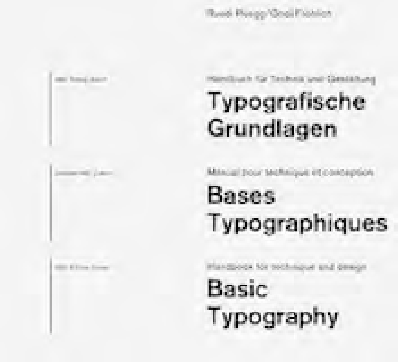Graphics Reference
In-Depth Information
TYPOGRAPHIC DESIGN PROCESS: CASE STUDY
Exploring typographic permutations
This project commenced in the postgraduate program in graphic design at the Basel
School of Design in Switzerland.The encouragement and criticism of Wolfgang
Weingart are gratefully acknowledged.
The range of potential solutions to a typographic problem is seemingly
infinite. Variations, permutations, and transformations can be
developed, exploring changes in both fundamental aspects and subtle
details. Processing typographic form in search of solutions involves a
process of insertion, substitution, and omission. After freely exploring
ideas and selecting those for further development, the designer explores
many permutations by inserting elements into the typographic space.
The space may be organized by a predetermined grid structure, or the
visual dynamics of the elements may define their own structures. This
initial process enables the designer to consider the placement of parts,
and most important, the relationship of the parts to the whole. Limiting
initial elements to the same size and weight provides a solid base for
the expansion of syntactic possibilities.
The substitution process replaces initial elements with alternative
elements in an effort to test and improve the hierarchy and legibility
of the text, as well as to heighten visual resonance. This is achieved
by assigning different sizes, weights, spacings, positions, and other
syntactic variations.
The omission phase eliminates superfluous or meaningless
elements, reduces elements to their essential form, and simplifies the
typographic field as a whole. The process then repeats itself until all
possibilities are exhausted and a viable solution to the problem is
revealed.
To create a title page, designer Thomas Detrie developed a
sequence of possible solutions. Detrie's approach to the design process
is based on his beliefs that “solutions come from within the problem”
and “ideas come from working with the material and are not supplied
or preconceived.”
Detrie's personal problem-solving method is a three-stage
design process: preliminary exploration, message investigation, and
visualization of solutions. In his preliminary exploration, Detrie
considered the nature and content of the problem and made sketches
to explore possible directions. Typographic information (title, subtitle,
authors, and publisher) was assigned priority.
Detrie raised the question, “For the topic
Basic Typography
, what
is basic to typography that can be signified in a visual solution?” His
answer established parameters appropriate to the given problem: a
right-angled system, black on white, printed and unprinted areas,
and a clear message. These considerations became the criteria for the
investigation.
12-18


